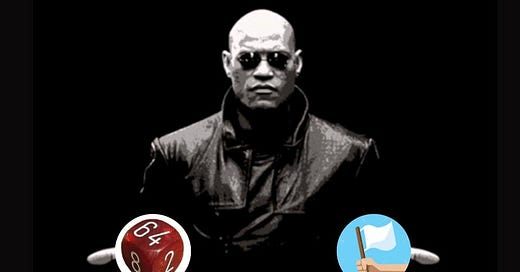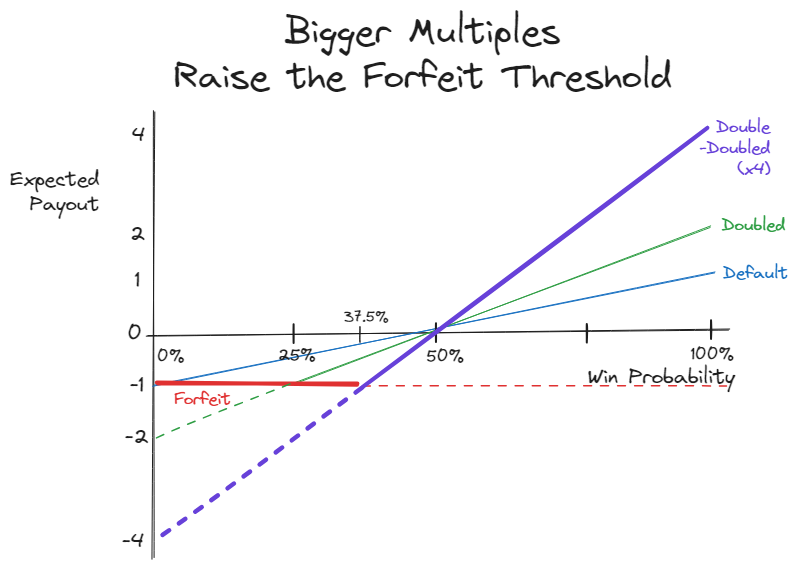Marvel Snap’s doubling cube (branded as “Snap!”) is a key innovation that adds depth and excitement to an otherwise simple strategy game. This mechanic is not new, but borrowed from the ancient game of Backgammon. The doubling cube is a calculated wager based on the game state and accelerates game pace by encouraging early strategic forfeiting. Marvel Snap in particular adds a bluffing dimension emergent from the hidden information of card games. Doubling cube style mechanics have immense potential in other competitive games, though the interplay with rankings and matchmaking do create complications.
Pick your poison
Doubling Cube Strategy
The doubling cube originates from Backgammon, traditionally a gambling game. The doubling cube is literally a cube: a six-sided die with the numbers 2, 4, 8, etc. on its faces. At any point in the game, a player may activate the doubling cube, offering their opponent the choice to either double the wager or forfeit. The doubling cube can be later reactivated by the opponent in a back-and-forth action. Backgammon is a relatively simple game and the doubling cube adds a much needed layer of depth.
Let’s dive into the math behind doubling strategy. The doubler’s decision is simple – if you are winning, you would rather win twice as much. Thus, you should double if your win probability is greater than 50%. The receiver has two options: accept the double, or forfeit the undoubled wager. If you are almost certainly going to lose with P(win) = 0%, your undoubled expected payout is -1. Doubling would drop it to -2, and you would rather forfeit and take the -1. If the game is even with P(win) = 50%, your expected payout is 0. Doubling this does not change your expected payout, only the variance, and you should accept it instead of forfeiting. The break-even point is at P(win) = 25%; accept the double above this threshold, and forfeit below.
The doubling receiver is given the choice to Forfeit (red) or Accept (green). The optimal choice is in bold, and depends on whether your win probability is above or below 25%.
The skill therein is assessing the game state to strategically double or forfeit. Skilled players can quickly assess if they are at an advantage and will aggressively double. It is trickier for the receiver to judge whether they are above or below 25% to decide whether to accept or forfeit.
Additionally, the doubling cube accelerates the pace of the game. By forcing a forfeit when P(win) < 25%, games conclude faster. Strategy games are particularly unpleasant to play when behind, as your decision space is severely limited when your resources are limited (more on this later). Games are more engaging when you have more interesting decisions to make and outcomes are uncertain, so quickly moving onto a new game creates a better experience for everyone.
Marvel Snap adds an additional bluffing element to the doubling cube, thanks to the hidden information of cards in your hand. Since the doubling cube decision depends on evaluating the game state, and hidden cards-in-hand add uncertainty, players can represent (or misrepresent) a position of power by doubling. This creates poker-like bluffing dynamics which adds a rich new texture to the game. For example, you may have a dominant boardstate but a weak hand and choose to activate the doubling cube in order to represent a strong hand and provoke a forfeit. In another scenario, you might have a very strong hand and want to double, but do not want to scare your opponent into forfeiting. To bait your opponent into accepting the double, you might purposefully play a weak turn before doubling, similar to a “check-raise” in poker.
Unfortunately, Snap’s minimalist mobile design restricts the social surface area for intricate bluffing. Social cues provide a rich set of signals to read and misrepresent. Any poker player will tell you that in-person poker is wildly different from online, as players are looking for shifty eyes, nervous fidgets, or coy smirks. Marvel Snap’s only forms of communication are a limited set of emotes and the time spent between turns. Facial expressions, voice chat, or even text chat would create additional social surface area for intricate reading and bluffing.
Snap also adds an additional twist with the automatic doubling on the final turn. This forces players to engage with the doubling cube’s 25% evaluation, as the mechanic may be unfamiliar and unused by new players. Moreover, you can manually double on top of the default doubling (a double-double, if you will), which raises the strategic forfeiting threshold to 37.5%.
When presented with a 4x wager, the receiver should forfeit at P(win) < 37.5%
Lastly, doubling creates high moments, adding texture to the otherwise monotonous stakes. In most competitive games from LoL to chess, players effectively wager ranked points (or elo) on each match. The wager is always the same, creating a flat experience where every game has the same stakes. Games like LoL try to create intensity spikes with promotion matches, where ranking up from silver to gold is contingent on victory. But in the back-end, the matchmaking rating (mmr) calculations are the same. With the doubling cube, some games will organically and unpredictably become higher-stakes. You may win 8 games in a row for a wager of 1, but lose it all on a doubled-and-redoubled game.
Applications in Other Games
The doubling cube is a fascinating yet simple mechanic that has broad applications in other competitive games. Strategy games like MOBAs and RTS in particular could benefit a lot from a doubling cube encouraging strategic forfeits. Strategy games are uniquely characterized by early decisions affecting the resources and options available later. In contrast, fighting games or shooters generally provide the same options regardless of game state; your ability to shoot the gun is not contingent on the last 10 minutes of gameplay. Playing strategy games from a disadvantageous position can feel awful, as your options are severely limited and victory depends on your opponent making multiple blunders. However, if your goal is to maximize your expected outcome, players might grind out unpleasant losing positions for that slim chance of victory. Starcraft players will have traumatic memories of a Terran opponent floating all their buildings to far-flung corners of the map, hoping to frustrate their opponent and win via disconnect. The doubling cube could force early forfeits at P(win) < 25%, giving players an option to quickly conclude the game instead of ratting it out.
Team games like League of Legends could furthermore benefit from doubling cube’s effect to coordinate forfeits. Most team games handle forfeiting via majority vote. In the absence of a doubling cube, players’ willingness to forfeit varies quite a lot. The win probability threshold to forfeit depends on how players value a loss compared to their time or moment-to-moment enjoyment in the game. Some players believe in the mantra of “never surrender, never give up!” while others are eager to move on and “go next”. Squabbles frequently break out between team members when one player wants to quit and another wants to hold their ground. With the doubling cube, a clear threshold is set at 25%, which might better align the team on a forfeit criteria.
Ranked points are a natural currency to wager via doubling cube. However, this may create complications with skill-based matchmaking. For the sake of this discussion, I will separate skill into mutually exclusive “game skill” and “wagering skill”. There are two basic scenarios: either matchmaking is directly based on rank, or matchmaking uses a game skill rating and rank is loosely rubber-banded to mmr. If matchmaking is directly based on rank (as in Marvel Snap, iirc), players may rise through the ranks due to their wagering skill but be consistently outclassed in game skill. This may create a bad experience where the player is consistently losing. If matchmaking is loosely tied to rank, a player may rise through the ranks without actually improving in skill due to their wagering skill, albeit lacking game skill. This creates odd scenarios where a bronze-game-skill player may rise to gold rank. This bronze-game-skill and gold-wagering-skill player would match against bronze opponents, creating a perception of poor matchmaking. This raises the question of what exactly ranks are measuring: game skill or wagering skill. If the community values game skill above wagering skill, a system that heavily weights wagering skill may be seen as illegitimate. Perhaps some intermediate compromise is the solution.
I have often marveled at the strategic depth created by poker’s wagering and bluffing, and wondered why it was not more commonplace among modern games. I hope the success of Marvel Snap’s doubling cube inspires more games to experiment with the mechanic.
In other news, I’m joining Second Dinner to work on Marvel Snap in a few weeks! Hit me up if you have any hot takes.






